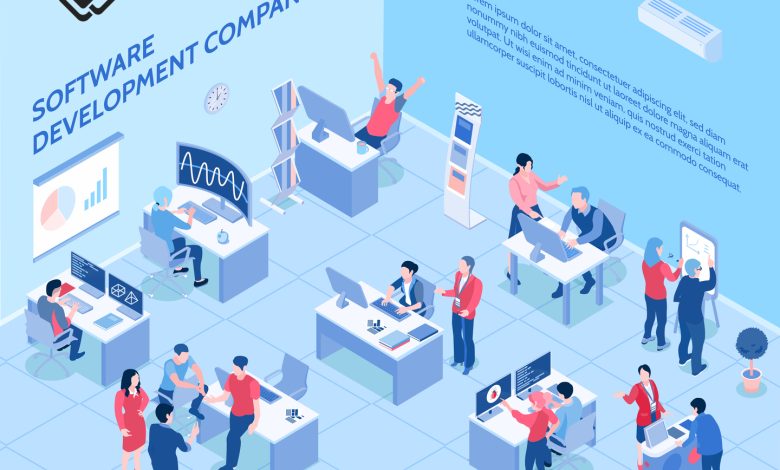DO WEB DEVELOPMENT AND SOFTWARE DEVELOPMENT MEAN THE SAME?

With the evolution of computer programming, a lot of things are happening in the field of computers extremely quickly. As a result, many terminologies are coined, many of which are misunderstood or used incorrectly. Web applications and software development are two phrases that are sometimes used interchangeably. Understanding the differences between the deliverables of a web app development company and a software development company is critical to make the correct choice for your business’s growth. Let’s take a closer look at them-
WEB APPLICATION
A web application is a program that is typically kept on a distant server and accessed by users through the use of web browser software. When it comes to online applications in general, they often use a combination of server-side scriptings such as PHP and ASP to handle data storage and retrieval. Some of them also employ client-side scripts like JavaScript and HTML to display data and information to users, and some web applications have both client-side and server-side scripts at the same time. It enables individuals to engage with the organization or companies via various features.
In addition, web applications allow customers to create documents, distribute them, and share data/information. In speaking, a web application can include online stores, webmail, calculator, social media tools, and other features. Regular web browsers are unable to access these types of online applications. Most online apps on the internet, on the other hand, may be accessible using a basic web browser.
WEB DEVELOPMENT
Web development is the process of breaking down large jobs into smaller ones and monitoring progress from start to finish to create a web application. Different approaches, such as Agile methodology, are used in web development to design or develop apps. The phases are as follows:
- Gathering requirements (Purpose, Goal, and audience)
- Preparation (Workflow creation)
- Conceptualization (Site page designing)
- Writing or content management
- Coding (building website)
- Evaluation
- Deployment, hosting, and upkeep are all important.
SOFTWARE DEVELOPMENT
The field of software development is concerned with the creation of computer programs. Software developers are in charge of designing, developing, programming, documenting, testing, and enhancing software, software modules, and interfaces. software developers develop Programs and tools for stand-alone mobile and desktop platforms. The developed software enables ordinary people to interface with computer equipment for a series of things and tasks.
The use of a range of programming languages such as Python, C#, Java, and SQL drive the creation and development of software. Because it has to manage the full end-to-end functionality of the software, code might be complicated. Many software technology companies, such as Oracle and Microsoft, have created tools that aid in the creation of user interfaces, applications, bug and error diagnostics, and even the automation of many processes in the design process.
A COMPARISON OF SOFTWARE DEVELOPMENT AND WEB DEVELOPMENT
- There is a significant difference between software development and web development in terms of the user interface.
- Screens are created with static content in software development. Static pages and dynamic online content can both be controlled in web development.
- Gaming and file handling are two areas where software-developed applications excel. Data centralization and multi-user applications developed on the web function better.
- Applications created with software can only be used on the machine in which they were installed.
Digital transitions are difficult and consuming, requiring a substantial commitment of time, money, and effort. They affect the entire organization, resulting in new modes of communication, a greater sense of togetherness, and a strong corporate culture. As a result, efficiency and production improve. IT outsourcing companies have become a common part of such a change, and it’s a trend that’s expected to grow in the coming years as companies battle with their digitalization ambitions. This is because software development companies assure top notch quality by using the best product development practices.
WHAT IS SOFTWARE OUTSOURCING?
Companies have access to the world’s finest software engineers in today’s fully digital corporate sector. Outsourcing software development provides a number of benefits, including cost savings, increased productivity, reduced risk, and greater security. Unlike in-house development, outsourcing is more efficient and cost-effective than renting office space and setting up an entire development infrastructure.
WHY SHOULD BUSINESSES OUTSOURCE SOFTWARE DEVELOPMENT?
1. Access to the best tech talent on the planet.
You’ll be able to locate the workforce that is suitable for your project’s demands if you browse through the firm’s portfolio, search for customer feedback, read the reviews, and sample the items that the business has provided.
2. Deep expertise and experience are available to you.
This is no surprise that software outsourcing is an excellent approach to compensate for a lack of internal resources, allowing you to concentrate on your main responsibilities. You may either continue to development or start by constructing a minimal viable product to verify your concept and make early adjustments as needed, based on your type of product, project specifications, and budget. In this situation, the outsourcing company’s marketing and design professionals will assist you in creating the best MVP and then interpreting the analytical data it generates.
3. The use of the Agile approach.
Adherence to the lean development philosophy is typically crucial for a startup. Managing projects this way reduces the possibility of unnecessary expenses, tasks, or issues resulting from inaccurate management. Poor communication, excessive complexity, or other issues related to the coordination of the project. Agile development enables on-the-fly revisions and modifying the development process to changing needs. This decreases the need to rework final elements to a minimum during the course of a project’s lifespan.
Amazon Web Services (AWS) is the most complete and widely used cloud platform in the world, with over 200 feature-packed services available from data centers all around the world. Custom software development companies are leveraging cloud services to deliver applications that fulfill clients requirements in the best way possible. Currently, millions of clients, such as the fastest-growing startups, biggest companies, and top government agencies, use AWS cloud computing to reduce costs, improve agility, and accelerate innovation. It has the following highlights:
- With nearly a billion customers and large numbers of partners across the world, AWS has the most engaged and vibrant community.
- You can explore and innovate more rapidly with AWS by leveraging the newest technology.
- From basic technologies like computing, storage, and databases to new technologies like AI and machine learning, data lakes and analytics, and the Internet of Things, AWS provides far more services and features than any other cloud provider.
- For your most critical applications, AWS offers unrivaled experience, maturity, dependability, security, and performance.
AWS AND SOFTWARE DEVELOPMENT
With AWS developer tools, you can quickly and easily host code, create, debug, and deploy your apps. For DevOps software development, use essential technologies such as continuous integration and delivery (CI/CD) services, software development kits (SDKs), and code editors. To increase responsiveness, privacy, velocity, and code quality, use machine learning (ML)-guided best practices and abstractions. Following are the characteristics:
- Make use of machine learning- Using machine learning and large data, detect problems and recommend solutions based on Amazon best practices.
- Faster software release- To expedite your software development and release cycle, use AWS developer tools to accomplish continuous integration and continuous delivery.
- Reduce the number of steps in the development process- Define application architecture in programming languages that are familiar and simple to use.
CASE STUDIES FOR AWS SOFTWARE DEVELOPMENT
- Boost the output of developers.
Without switching contexts or leaving your editor, you may manage services, supply services, and automate development processes.
2. Reduce downtime as much as possible.
Build highly available apps on resilient cloud architecture to empower your teams to react, adapt, and restore fast in the face of unforeseen occurrences.
3. Automate and test Infrastructure
To provide scaling and consistency to provisioning and administration, integrate infrastructure as code (IaC) with configuration files and automated, continuous integration.
4. Automate CI/CD pipelines
Remove manual processes that are prone to errors, as well as the requirement to monitor software releases. Develop, test, and deploy software using software release processes.
5. Keep an eye on things.
Create a quantitative measurements dashboard to get real-time and ongoing insight into the operations of your system.





